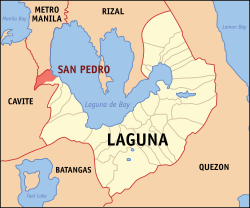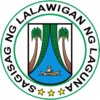San Pedro, Laguna
San Pedro ᜐᜈ̟ ᜉ̄ᜇ̟ᜇ̵̥ Lungsod ng San Pedro | ||
|---|---|---|
 | ||
| ||
 Mapa ng Laguna na nagpapapakita sa Lungsod ng San Pedro. | ||
 | ||
| Mga koordinado: 14°21′30″N 121°03′30″E / 14.3583°N 121.0583°E | ||
| Bansa | ||
| Rehiyon | Calabarzon (Rehiyong IV-A) | |
| Lalawigan | Laguna | |
| Distrito | Unang Distrito ng Laguna | |
| Mga barangay | 27 (alamin) | |
| Pagkatatag | 18 Enero 1725 | |
| Pamahalaan | ||
| • Punong Lungsod | Hon. Lourdes Cataquiz | |
| • Pangalawang Punong Lungsod | Art Joseph Francis Mercado | |
| • Manghalalal | 174,499 botante (2022) | |
| Lawak | ||
| • Kabuuan | 24.05 km2 (9.29 milya kuwadrado) | |
| Populasyon (Senso ng 2020) | ||
| • Kabuuan | 326,001 | |
| • Kapal | 14,000/km2 (35,000/milya kuwadrado) | |
| • Kabahayan | 82,292 | |
| Ekonomiya | ||
| • Kaurian ng kita | ika-3 klase ng kita ng lungsod | |
| • Antas ng kahirapan | 5.99% (2021)[2] | |
| • Kita | (2022) | |
| • Aset | (2022) | |
| • Pananagutan | (2022) | |
| • Paggasta | (2022) | |
| Sona ng oras | UTC+8 (PST) | |
| Kodigong Pangsulat | 4023 | |
| PSGC | 043425000 | |
| Kodigong pantawag | 2 | |
| Uri ng klima | Tropikal na monsoon na klima | |
| Mga wika | wikang Tagalog | |
| Websayt | cityofsanpedrolaguna.gov.ph | |
Ang Lungsod ng San Pedro ay isang ika-1 klaseng lungsod sa lalawigan ng Laguna, Pilipinas. Ang pangalan nito ay isinunod sa santong patron nito, Si San Pedro. Ang San Pedro ay ang unang bayan ng Laguna na madadaan mula sa Kalakhang Maynila. Ang lugar ng San Pedro ay kilala bilang isang pamayanang pantahanan (residential), kung saan marami ang nagbabyahe patungong Kalakhang Maynila upang magtrabaho. Ayon sa senso ng 2020, ito ay may populasyon na 326,001 sa may 82,292 na kabahayan.
Mga Barangay
[baguhin | baguhin ang wikitext]
Ang lungsod ng San Pedro ay nahahati sa 27 barangay.
|
|
|
Mga Pagdiriwang
[baguhin | baguhin ang wikitext]Ang Pista ng Sampaguita ay isang malaking pista na ginanap sa buong bayan, simula ika-21 o 22 Pebrero na kadalasang inaabot ng isang linggo, na kinapalolooban ng mga parada, 'Hiyas ng San Pedro'-patimpalak sa Kagandahan, patimpalak sa pag-awit, mga pampalakasan, pag-sayaw ng mga katutubong sayaw-'Street Dancing', atbp. Ang Pista ay nag-nanais na maigunita ang kahalagahan ng Sampaguita sa kultura ng San Pedro, makahikayat ng turismo at paunlarin ang industriya ng sampaguita sa bayan.
Mga kilalang tao
[baguhin | baguhin ang wikitext]Rene M. Alviar, batikang peryodista ng Inquirer, Bulletin, at Star, at ngayo'y kolumnista sa Tutubi.ph
Art Joseph Francis Mercado, Pangalawang Punong Lungsod (2019- Konsehal (2016-2019)
Demograpiko
[baguhin | baguhin ang wikitext]| Taon | Pop. | ±% p.a. |
|---|---|---|
| 1903 | 3,678 | — |
| 1918 | 4,184 | +0.86% |
| 1939 | 6,300 | +1.97% |
| 1948 | 9,063 | +4.12% |
| 1960 | 14,082 | +3.74% |
| 1970 | 32,991 | +8.88% |
| 1975 | 43,439 | +5.67% |
| 1980 | 74,556 | +11.40% |
| 1990 | 156,486 | +7.70% |
| 1995 | 189,333 | +3.63% |
| 2000 | 231,403 | +4.40% |
| 2007 | 281,808 | +2.76% |
| 2010 | 294,310 | +1.59% |
| 2015 | 325,809 | +1.96% |
| 2020 | 326,001 | +0.01% |
| Sanggunian: PSA[3][4][5][6] | ||
Mga sanggunian
[baguhin | baguhin ang wikitext]- ↑
"Province: Laguna". PSGC Interactive. Quezon City, Philippines: Philippine Statistics Authority. Nakuha noong 12 Nobyembre 2016.
{{cite web}}: CS1 maint: date auto-translated (link) - ↑ "PSA Releases the 2021 City and Municipal Level Poverty Estimates". Pangasiwaan ng Estadistika ng Pilipinas. 2 Abril 2024. Nakuha noong 28 Abril 2024.
{{cite web}}: CS1 maint: date auto-translated (link) - ↑
Census of Population (2015). "Region IV-A (Calabarzon)". Total Population by Province, City, Municipality and Barangay. PSA. Nakuha noong 20 Hunyo 2016.
{{cite ensiklopedya}}: CS1 maint: date auto-translated (link) - ↑
Census of Population and Housing (2010). "Region IV-A (Calabarzon)". Total Population by Province, City, Municipality and Barangay. NSO. Nakuha noong 29 Hunyo 2016.
{{cite ensiklopedya}}: CS1 maint: date auto-translated (link) - ↑
Censuses of Population (1903–2007). "Region IV-A (Calabarzon)". Table 1. Population Enumerated in Various Censuses by Province/Highly Urbanized City: 1903 to 2007. NSO.
{{cite ensiklopedya}}: CS1 maint: url-status (link) - ↑
"Province of Laguna". Municipality Population Data. Local Water Utilities Administration Research Division. Nakuha noong Disyembre 17, 2016.
{{cite web}}: CS1 maint: date auto-translated (link)
Mga Kawing Panlabas
[baguhin | baguhin ang wikitext]- Philippine Standard Geographic Code Naka-arkibo 2012-04-13 sa Wayback Machine.



